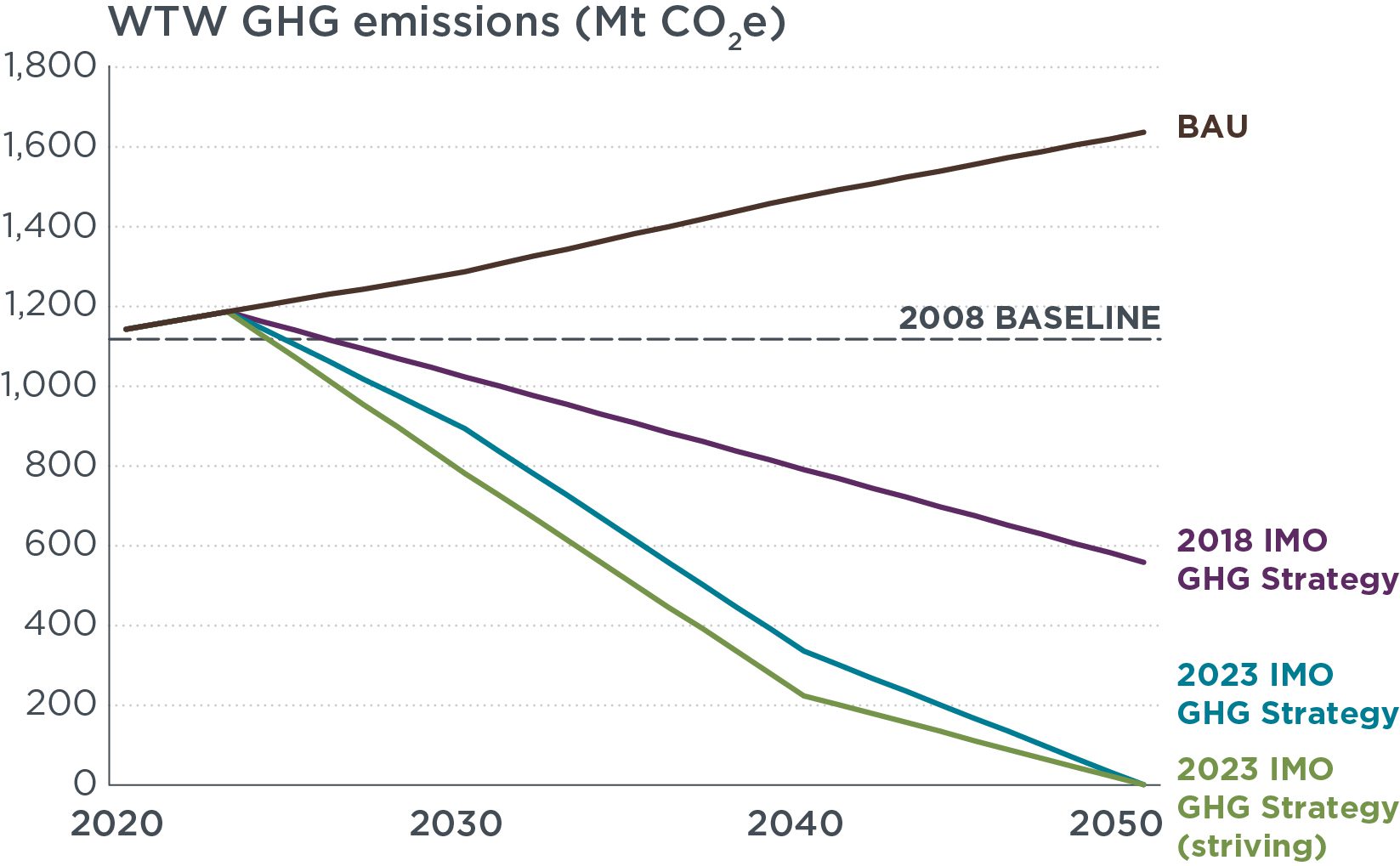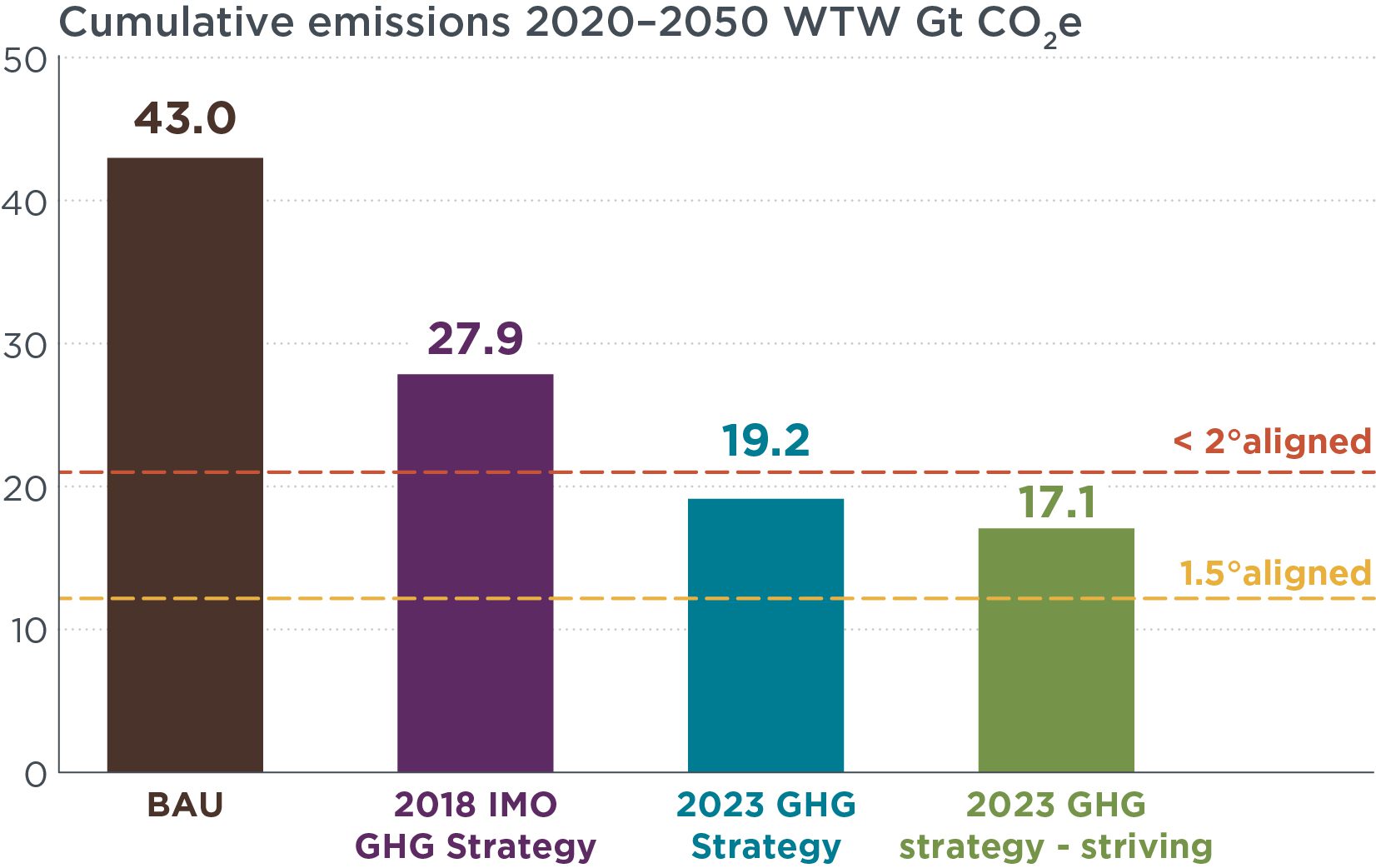Blog
IMO’s newly revised GHG strategy: What it means for shipping and the Paris Agreement
In the first scheduled revision of the International Maritime Organization’s (IMO’s) greenhouse gas (GHG) strategy, member states just agreed to (1) reach net-zero GHG emissions by or around 2050 and (2) “indicative checkpoints” that call for reducing total GHG emissions by 20% and striving for 30% by 2030 and 70% and striving for 80% by 2040, both relative to 2008. This is a big improvement on the IMO’s initial GHG strategy, set in 2018, which aimed to cut GHG emissions by only 50% by 2050 and contained no absolute emissions reduction targets for the intervening years.
The initial strategy wasn’t compatible with the Paris Agreement’s aim to limit global warming to well below 2°C and pursuing efforts to limit it to 1.5°C. By our new estimates of the revised strategy, international shipping will exceed its current share of the world’s 1.5°C carbon budget by approximately 2032 but will not exceed the well below 2°C carbon budget (“well below” interpreted as 1.7°C) if it follows the emissions reduction pathway implied by this revised strategy.
The revised strategy’s “zero date” of by or around 2050 and its focus on life-cycle emissions are both key improvements. The latter are measured in terms of CO2e100, which refers to carbon dioxide equivalent emissions based on the 100-year global warming potentials of carbon dioxide, methane, and nitrous oxide. This blog post explained why it’s important that the IMO’s strategy include a year by which life-cycle, well-to-wake (WTW) GHG emissions would fall to zero and that it be not later than 2050.
In that same blog post, we estimated that the sector could only emit 10 gigatonnes (Gt) of cumulative tank-to-wake (TTW) CO2 from 2020 onward to align with 1.5°C. To keep well below 2°C (also interpreted as 1.7°C), the budget increased to 17 Gt TTW CO2. Because the IMO’s revised GHG strategy focuses on life-cycle emissions, let’s explore how much WTW CO2e100 is now available in the budget.
Based on the emission factors in this study and the international shipping fuel mix from the Fourth IMO GHG Study, we estimate that the ratio of WTW CO2e100 to TTW CO2 for international shipping is currently 1.21 to 1. This implies that the sector’s carbon budget is approximately 12 Gt WTW CO2e100 for 1.5°C and 21 Gt for well below 2°C. These are associated with a 67% probability of limiting global temperature rise to these levels. Using the same ratio and emissions data and projections from the Fourth IMO GHG Study, we estimate that international shipping currently emits about 1.1 Gt of WTW CO2e100 annually and that’s growing by about 1.3% on average each year. That places the sector on a track to exceed the 1.5°C budget by 2030 and the well below 2°C budget by 2037. With the emissions reductions expected under the initial GHG strategy, the 1.5°C budget is not exceeded until 1 year later, by 2031, and the 2°C budget is expended by 2041.
How do things change with the revised strategy? The first chart below compares a straight-line emissions trajectory that satisfies the emissions reduction targets in the revised (2023) GHG strategy with the pathway implied by the initial GHG strategy. The second chart shows the cumulative WTW CO2e100 emissions between 2020 and 2050 compared with the 1.5°C and well below 2°C carbon budgets. As you can see, the revised strategy is not compatible with 1.5°C but is compatible with well below 2°C. Had member states agreed to achieve zero emissions by 2040, the strategy would have been aligned with 1.5°C. Under the revised (2023) strategy, we’re set to exceed the 1.5°C budget by approximately 2032 under either the 20% or 30% (striving) target; however, if shipping can get to zero WTW CO2e emissions by 2050 along this pathway, it will not exceed its well below 2°C budget. Following the “striving” trajectory results in 17.1 Gt of cumulative WTW CO2e emissions, less than the 19.2 Gt under the less ambitious 2023 targets, and that improves the probability of keeping well below 2°C.

Figure 1. Well-to-wake GHG emissions pathways implied by the revised (2023) strategy compared to the initial (2018) strategy, the emissions in 2008, and business-as-usual (BAU) emissions.

Figure 2. Cumulative well-to-wake GHG emissions from 2020–2050 implied by straight-line emissions reduction pathways for the revised (2023) strategy, the initial (2018) strategy, and business-as-usual (BAU), compared to the 1.5°C and well below 2°C budgets.
While this revised strategy is not legally binding, the measures used to implement it can be. After the initial GHG strategy, the IMO agreed on “short-term measures” to regulate GHG emissions from ships. Two of these entered into force in 2023: the Energy Efficiency Existing Ship Index (EEXI) and the Carbon Intensity Indicator (CII). These measures are legally binding because they are incorporated into an international treaty, the International Convention for the Prevention of Pollution from Ships (MARPOL, for short). Unfortunately, we don’t expect their current iterations to meaningfully drive down emissions. The EEXI is not stringent enough—it’s expected to avoid about 1% of future emissions by 2030—and the CII merely grades ships from A to E. Luckily, though, both measures are set to be revised by no later than January 1, 2026. Changing these to be more effective can include regulating CO2e emissions, not just CO2, covering WTW emissions under CII, and increasing their required emissions reductions.
For the CII, there’s more that can be done. Each ship’s CII score could be published so the market can reward or punish ships that overperform or underperform. Plus, there could be consequences for ships that consistently score D or E. Right now, ships that receive a D for three consecutive years or an E in any year are required to draft and implement a plan of corrective actions. However, there are no requirements for what must be included in these plans, and there is never a time when a ship’s environmental certificates are revoked, no matter how many times the ship fails.
Beyond the short-term measures there are also mid-term measures being developed at the IMO that could enter into force as soon as 2027. The “basket of measures,” as IMO delegates are calling it, will include a technical element and an economic element. The technical element is expected to be a GHG fuel standard (GFS) that will gradually reduce the allowable WTW CO2e intensity of marine fuels. The economic element is less-well-defined; there are several things being considered, including a GHG fuel levy, a feebate program, and a cap-and-trade scheme. With regard to the GFS, we presented work based on ICCT’s Polaris energy use and emissions projection model at an IMO expert workshop and it showed that aligning with 1.5°C would require a 38% reduction in the WTW GHG intensity of marine fuels by 2030, 97% by 2040, and 100% by 2050.
Finally, countries and regions can also set their own requirements for ships that call on their ports. The European Union did this under FuelEU Maritime, which is similar to the proposed IMO GFS, and by incorporating shipping into its Emissions Trading System. Success in decarbonizing shipping will likely require international rules complemented by more ambitious regional, national, and sub-national rules. As governments develop and amend laws and regulations to enable a timely transition in the sector, the ICCT will provide technical advice and analysis to support policies that effectively reduce WTW CO2e emissions from global shipping. And we’ll be in the room when the IMO revises its GHG strategy again in 2028.
Authors

Bryan Comer, Ph.D
Program Lead

Francielle Carvalho, Ph.D.
Associate Researcher
